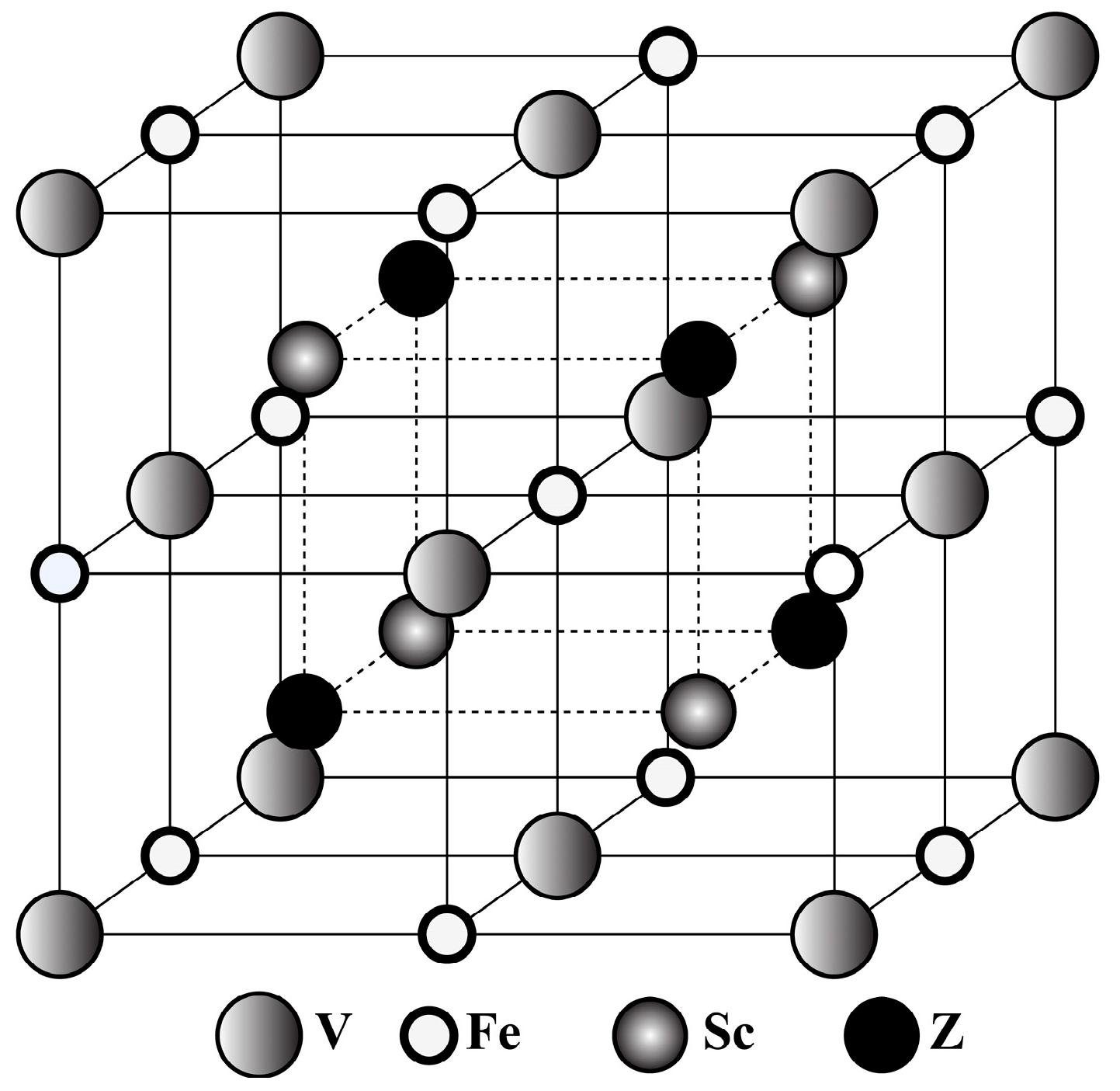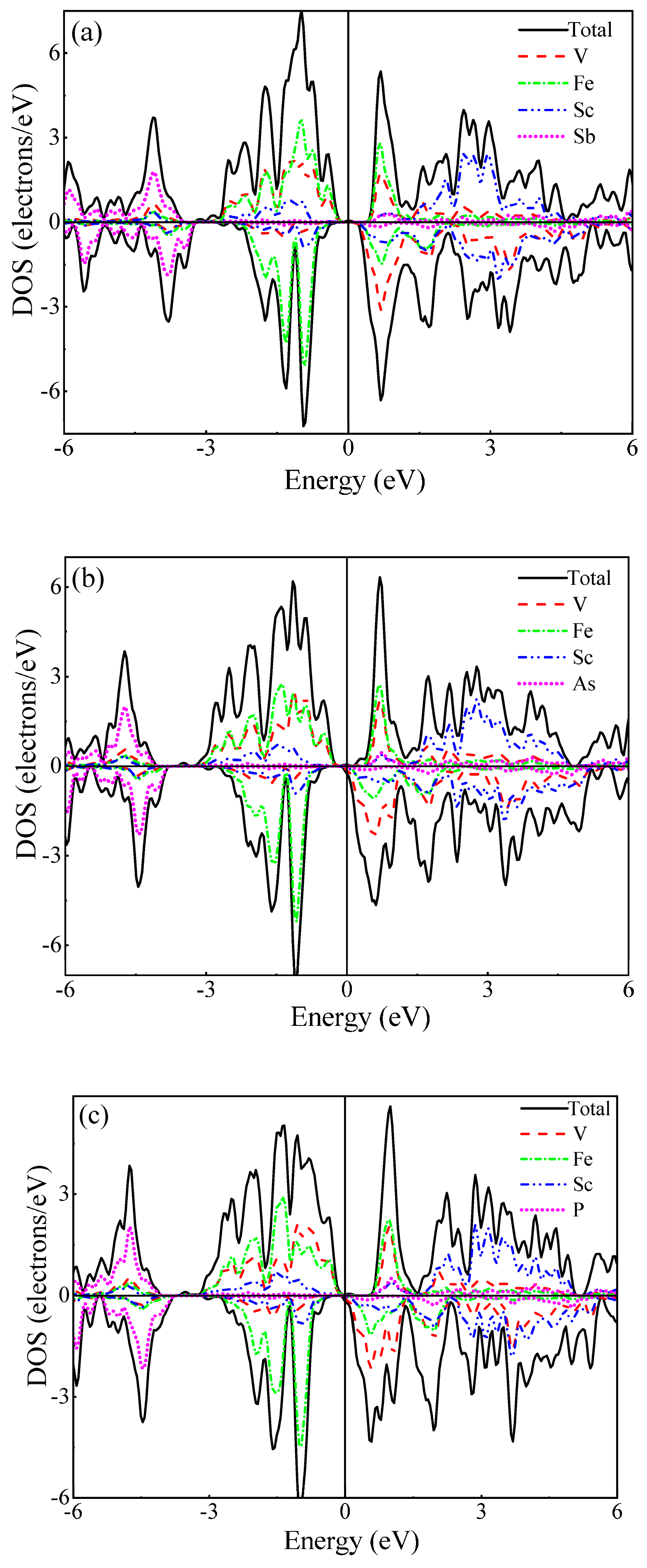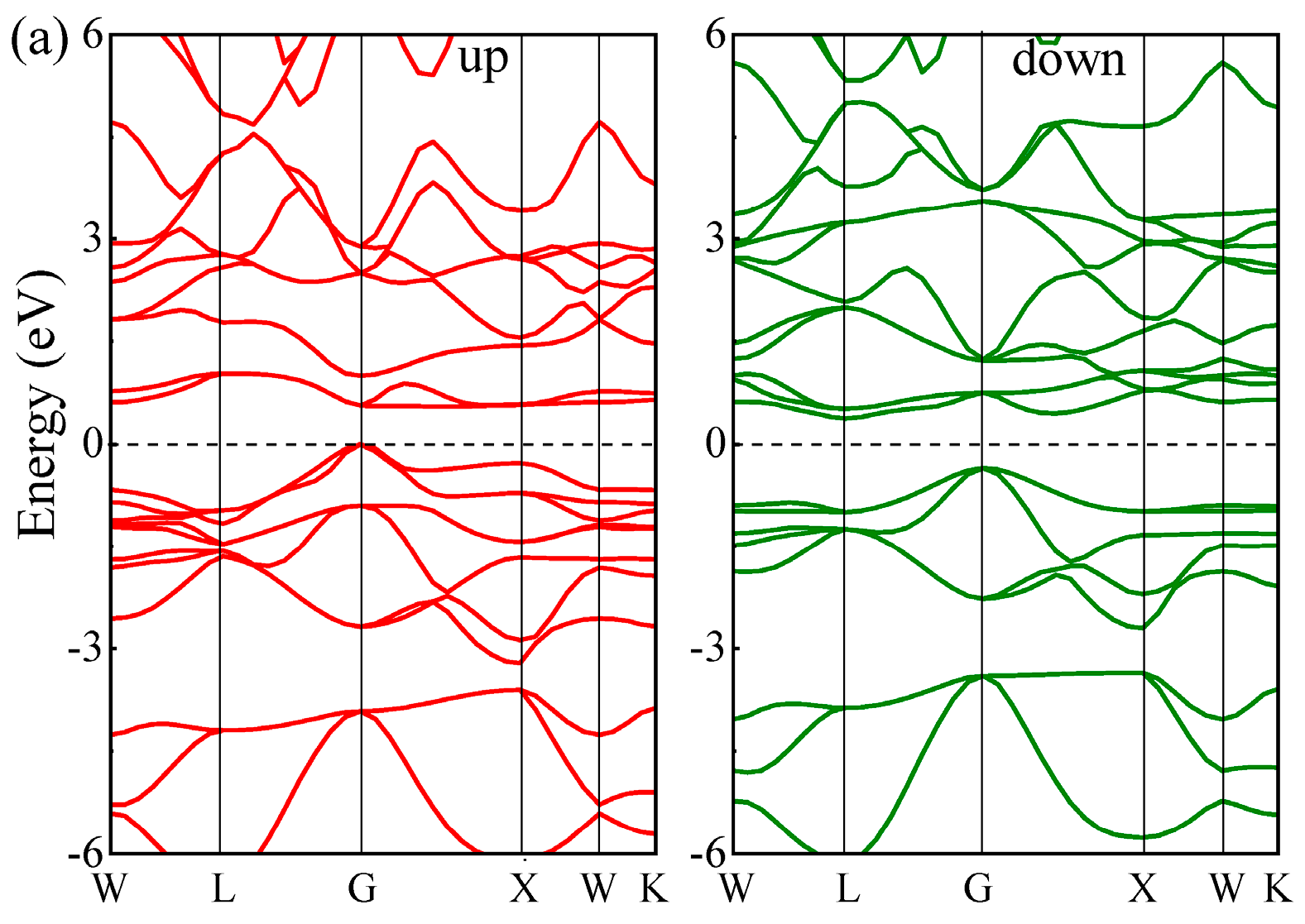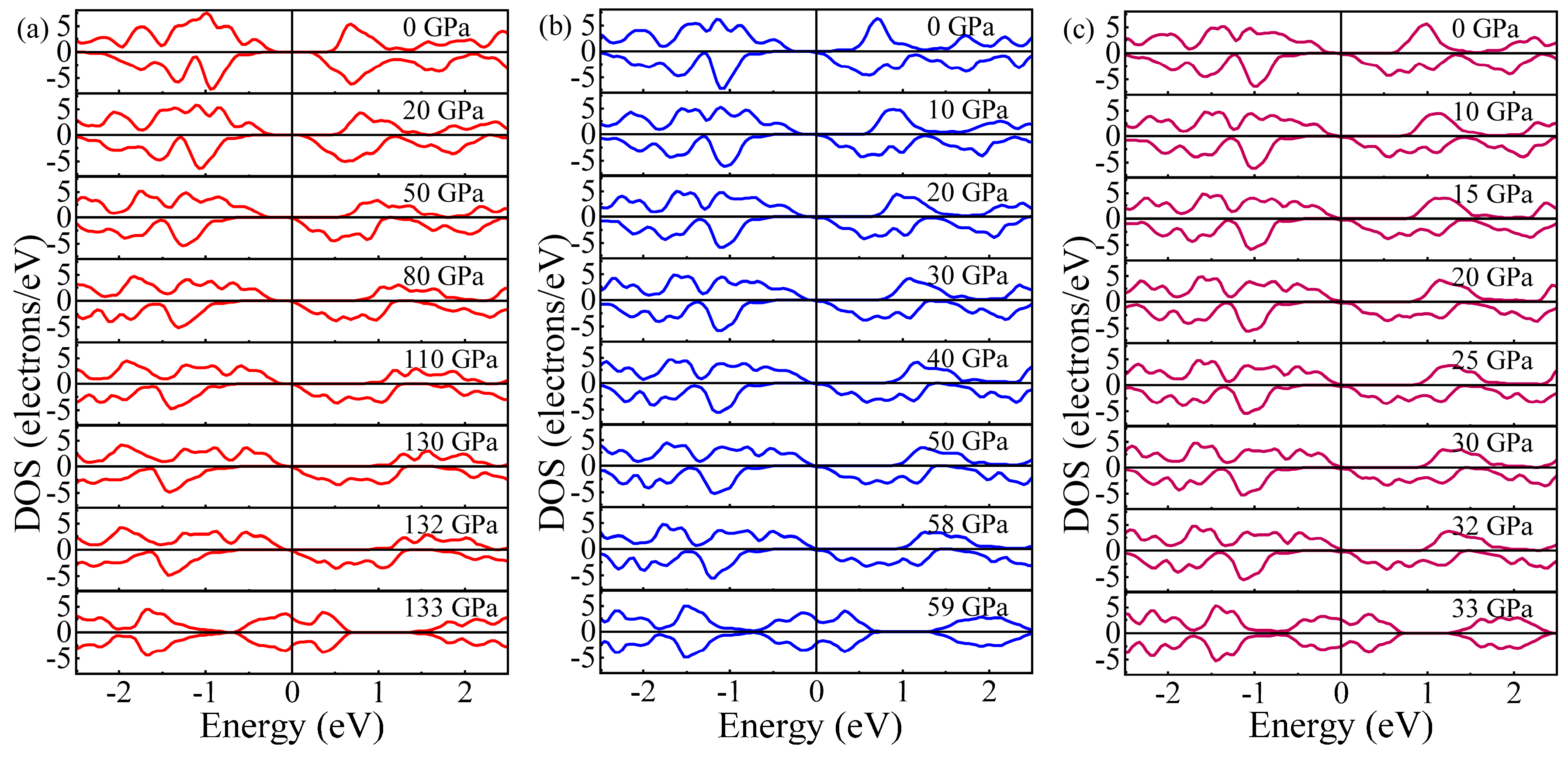High-Pressure-Induced Transition from Ferromagnetic Semiconductor to Spin Gapless Semiconductor in Quaternary Heusler Alloy VFeScZ (Z = Sb, As, P)
Abstract
:1. Introduction
2. Structures and Calculation Methods
3. Results and Discussion
3.1. Bulk Properties of VFeScZ (Z = Sb, As, P)
3.2. Pressure Effect of VFeScZ (Z = Sb, As, P)
4. Conclusions
Author Contributions
Funding
Conflicts of Interest
References
- Fu, H.; Li, Y.; Ma, L.; You, C.; Zhang, Q.; Tian, N. Structures, magnetism and transport properties of the potential spin-gapless semiconductor CoFeMnSi alloy. J. Magn. Magn. Mater. 2019, 473, 16–20. [Google Scholar] [CrossRef]
- Ueda, K.; Hirose, S.; Asano, H. Ambipolar transport in Mn2CoAl films by ionic liquid gating. Appl. Phys. Lett. 2017, 110, 202405. [Google Scholar] [CrossRef]
- Wang, X. Proposal for a new class of materials: Spin gapless semiconductors. Phys. Rev. Lett. 2008, 100, 156404. [Google Scholar] [CrossRef] [PubMed]
- Huang, H.; Jiang, Z.; Yang, J.; Xiong, Y.; He, Z.; Zhu, Z.; Laref, A. First principles study of RbVF3: A spin gapless semiconductor under high pressure. Chin. J. Phys. 2019, 58, 132–136. [Google Scholar] [CrossRef]
- Wang, X.-L. Dirac spin-gapless semiconductors: Promising platforms for massless and dissipationless spintronics and new (quantum) anomalous spin Hall effects. Natl. Sci. Rev. 2017, 4, 252–257. [Google Scholar] [CrossRef]
- Patel, P.D.; Shinde, S.; Gupta, S.D.; Dabhi, S.D.; Jha, P.K. The first principle calculation of structural, electronic, magnetic, elastic, thermal and lattice dynamical properties of fully compensated ferrimagnetic spin-gapless heusler alloy Zr2MnGa. Comput. Condens. Matter 2018, 15, 61–68. [Google Scholar] [CrossRef]
- Deng, Y.-X.; Chen, S.-Z.; Zeng, Y.; Feng, Y.; Zhou, W.-X.; Tang, L.-M.; Chen, K.-Q. Spin gapless semiconductor and half-metal properties in magnetic penta-hexa-graphene nanotubes. Org. Electron. 2018, 63, 310–317. [Google Scholar] [CrossRef]
- Wu, H.; Qian, Y.; Tan, W.; Kan, E.; Lu, R.; Deng, K. Vacancy-induced insulator–direct spin gapless semiconductor–half-metal transition in double perovskite La2CrFeO6: A first-principles study. Phys. Lett. A 2015, 379, 2897–2901. [Google Scholar] [CrossRef]
- Skaftouros, S.; Özdoğan, K.; Şaşıoğlu, E.; Galanakis, I. Search for spin gapless semiconductors: The case of inverse Heusler compounds. Appl. Phys. Lett. 2013, 102, 022402. [Google Scholar] [CrossRef] [Green Version]
- Ouardi, S.; Fecher, G.H.; Felser, C.; Kübler, J. Realization of Spin Gapless Semiconductors: The Heusler Compound Mn2CoAl. Phys. Rev. Lett. 2013, 110, 100401. [Google Scholar] [CrossRef]
- Galanakis, I.; Dederichs, P.; Papanikolaou, N. Slater-Pauling behavior and origin of the half-metallicity of the full-Heusler alloys. Phys. Rev. B 2002, 66, 174429. [Google Scholar] [CrossRef] [Green Version]
- Galanakis, I.; Dederichs, P.; Papanikolaou, N. Origin and properties of the gap in the half-ferromagnetic Heusler alloys. Phys. Rev. B 2002, 66, 134428. [Google Scholar] [CrossRef] [Green Version]
- Zhang, L.; Cheng, Z.; Wang, X.; Khenata, R.; Rozale, H. First-principles investigation of equiatomic quaternary heusler alloys NbVMnAl and NbFeCrAl and a discussion of the generalized electron-filling rule. J. Supercond. Nov. Magn. 2018, 31, 189–196. [Google Scholar] [CrossRef]
- Bahnes, A.; Boukortt, A.; Abbassa, H.; Aimouch, D.; Hayn, R.; Zaoui, A. Half-metallic ferromagnets behavior of a new quaternary Heusler alloys CoFeCrZ (Z = P, As and Sb): Ab-initio study. J. Alloys Compd. 2018, 731, 1208–1213. [Google Scholar] [CrossRef]
- Gao, Q.; Xie, H.-H.; Li, L.; Lei, G.; Deng, J.-B.; Hu, X.-R. First-principle study on some new spin-gapless semiconductors: The Zr-based quaternary Heusler alloys. Superlattices Microstruct. 2015, 85, 536–542. [Google Scholar] [CrossRef] [Green Version]
- Osafile, O.; Adebambo, P.; Adebayo, G. Elastic constants and observed ferromagnetism in inverse Heusler alloy Ti2CoAs using kjpaw pseudopotentials: A first-principles approach. J. Alloys Compd. 2017, 722, 207–211. [Google Scholar] [CrossRef]
- Singh, M.; Kashyap, M.K.; Saini, H.S. Corroborating the Spin Gapless Character of Ti2Mnal Inverse Heusler Alloy: A study of Strains Effect. Mater. Today Proc. 2018, 5, 15421–15425. [Google Scholar] [CrossRef]
- Wang, L.; Jin, Y. A spin-gapless semiconductor of inverse Heusler Ti2CrSi alloy: First-principles prediction. J. Magn. Magn. Mater. 2015, 385, 55–59. [Google Scholar] [CrossRef]
- Yang, X.; Wu, X.; Wu, B.; Feng, Y.; Li, P.; Huang, H. First-principles calculated spin-gapless semiconducting behavior in quaternary VCoHfGa and CrFeHfGa Heusler compounds. Mater. Sci. Eng. B 2016, 209, 45–50. [Google Scholar] [CrossRef]
- Li, J.; Yang, G.; Yang, Y.; Ma, H.; Zhang, Q.; Zhang, Z.; Fang, W.; Yin, F.; Li, J. Electronic and thermoelectric properties of nonmagnetic inverse Heusler semiconductors Sc2FeSi and Sc2FeGe. J. Magn. Magn. Mater. 2017, 442, 371–376. [Google Scholar] [CrossRef]
- Perdew, J.P.; Burke, K.; Ernzerhof, M. Generalized gradient approximation made simple. Phys. Rev. Lett. 1996, 77, 3865. [Google Scholar] [CrossRef] [PubMed]
- Vanderbilt, D. Soft self-consistent pseudopotentials in a generalized eigenvalue formalism. Phys. Rev. B 1990, 41, 7892. [Google Scholar] [CrossRef] [PubMed]











| Structure | Type | E | L | MV | MFe | MSc | MSb | MTotal |
|---|---|---|---|---|---|---|---|---|
| VFeScSb | I | −4270.94176 | 6.34 | 3.18 | −0.12 | 0.16 | −0.20 | 3.02 |
| II | −4269.79299 | 6.38 | 2.08 | 0.48 | 0.54 | −0.12 | 2.98 | |
| III | −4270.39456 | 6.44 | 0.96 | 2.32 | −0.34 | 0.06 | 3.00 | |
| VFeScAs | I | −4292.08041 | 6.08 | 2.96 | 0.08 | 0.14 | −0.18 | 3.00 |
| II | −4291.1535 | 6.14 | 2.32 | 0.02 | 0.60 | −0.14 | 2.80 | |
| III | −4292.05693 | 6.19 | −0.16 | 2.34 | −0.18 | 0.18 | 2.18 | |
| VFeScP | I | −4299.87526 | 5.93 | 2.82 | 0.22 | 0.10 | −0.16 | 2.98 |
| II | −4298.93401 | 5.96 | 1.32 | 0.36 | 0.38 | −0.04 | 2.02 | |
| III | −4299.84489 | 6.05 | −0.04 | 2.22 | −0.14 | 0.12 | 2.16 |
© 2019 by the authors. Licensee MDPI, Basel, Switzerland. This article is an open access article distributed under the terms and conditions of the Creative Commons Attribution (CC BY) license (http://creativecommons.org/licenses/by/4.0/).
Share and Cite
Huang, H.; Yang, K.; Zhao, W.; Zhou, T.; Yang, X.; Wu, B. High-Pressure-Induced Transition from Ferromagnetic Semiconductor to Spin Gapless Semiconductor in Quaternary Heusler Alloy VFeScZ (Z = Sb, As, P). Appl. Sci. 2019, 9, 2859. https://doi.org/10.3390/app9142859
Huang H, Yang K, Zhao W, Zhou T, Yang X, Wu B. High-Pressure-Induced Transition from Ferromagnetic Semiconductor to Spin Gapless Semiconductor in Quaternary Heusler Alloy VFeScZ (Z = Sb, As, P). Applied Sciences. 2019; 9(14):2859. https://doi.org/10.3390/app9142859
Chicago/Turabian StyleHuang, Haishen, Kun Yang, Wan Zhao, Tingyan Zhou, Xiude Yang, and Bo Wu. 2019. "High-Pressure-Induced Transition from Ferromagnetic Semiconductor to Spin Gapless Semiconductor in Quaternary Heusler Alloy VFeScZ (Z = Sb, As, P)" Applied Sciences 9, no. 14: 2859. https://doi.org/10.3390/app9142859





